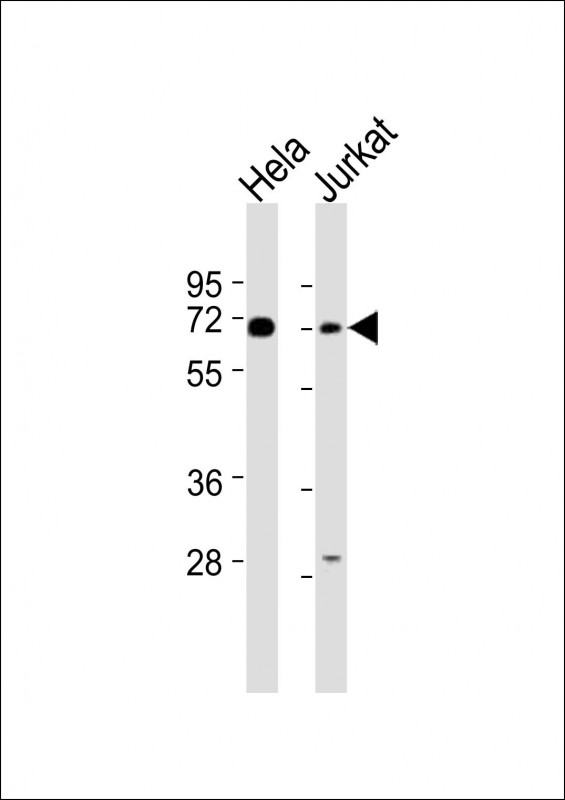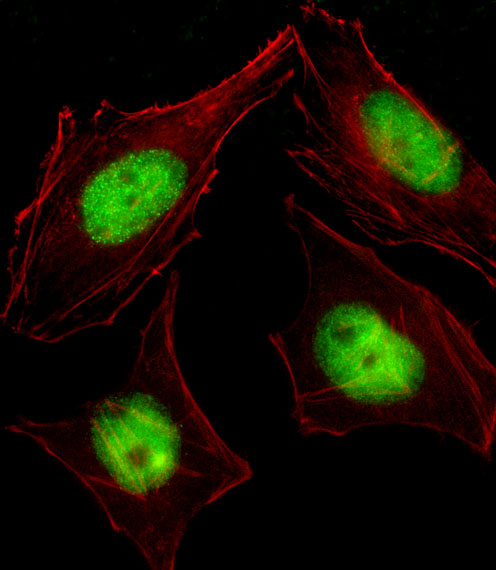CBFA2T2 Antibody (N-term)
Affinity Purified Rabbit Polyclonal Antibody (Pab)
- 产品详情
- 实验流程
- 背景知识
Application
| IF, WB, E |
|---|---|
| Primary Accession | O43439 |
| Other Accession | NP_001028171.1, NP_005084.1 |
| Reactivity | Human |
| Host | Rabbit |
| Clonality | Polyclonal |
| Isotype | Rabbit IgG |
| Calculated MW | 67133 Da |
| Antigen Region | 1-29 aa |
| Gene ID | 9139 |
|---|---|
| Other Names | Protein CBFA2T2, ETO homologous on chromosome 20, MTG8-like protein, MTG8-related protein 1, Myeloid translocation-related protein 1, p85, CBFA2T2, EHT, MTGR1 |
| Target/Specificity | This CBFA2T2 antibody is generated from rabbits immunized with a KLH conjugated synthetic peptide between 1-29 amino acids from the N-terminal region of human CBFA2T2. |
| Dilution | IF~~1:10~50 WB~~1:2000 E~~Use at an assay dependent concentration. |
| Format | Purified polyclonal antibody supplied in PBS with 0.09% (W/V) sodium azide. This antibody is purified through a protein A column, followed by peptide affinity purification. |
| Storage | Maintain refrigerated at 2-8°C for up to 2 weeks. For long term storage store at -20°C in small aliquots to prevent freeze-thaw cycles. |
| Precautions | CBFA2T2 Antibody (N-term) is for research use only and not for use in diagnostic or therapeutic procedures. |
| Name | CBFA2T2 |
|---|---|
| Synonyms | EHT, MTGR1 |
| Function | Transcriptional corepressor which facilitates transcriptional repression via its association with DNA-binding transcription factors and recruitment of other corepressors and histone-modifying enzymes (PubMed:12559562, PubMed:15203199). Via association with PRDM14 is involved in regulation of embryonic stem cell (ESC) pluripotency (PubMed:27281218). Involved in primordial germ cell (PCG) formation. Stabilizes PRDM14 and OCT4 on chromatin in a homooligomerization- dependent manner (By similarity). Can repress the expression of MMP7 in a ZBTB33-dependent manner (PubMed:23251453). May function as a complex with the chimeric protein RUNX1/AML1-CBFA2T1/MTG8 (AML1-MTG8/ETO fusion protein) which is produced in acute myeloid leukemia with the chromosomal translocation t(8;21). May thus be involved in the repression of AML1-dependent transcription and the induction of G- CSF/CSF3-dependent cell growth. May be a tumor suppressor gene candidate involved in myeloid tumors with the deletion of the 20q11 region. Through heteromerization with CBFA2T3/MTG16 may be involved in regulation of the proliferation and the differentiation of erythroid progenitors by repressing the expression of TAL1 target genes (By similarity). Required for the maintenance of the secretory cell lineage in the small intestine. Can inhibit Notch signaling probably by association with RBPJ and may be involved in GFI1-mediated Paneth cell differentiation (By similarity). |
| Cellular Location | Nucleus. |
| Tissue Location | Ubiquitously expressed in fetal and adult tissues. Highly expressed in adult brain, heart, lung, kidney, lymph node, appendix, thymus, testis, uterus, small intestine, prostate and thymus |
For Research Use Only. Not For Use In Diagnostic Procedures.
Provided below are standard protocols that you may find useful for product applications.
BACKGROUND
In acute myeloid leukemia, especially in the M2 subtype, the t(8;21)(q22;q22) translocation is one of the most frequent karyotypic abnormalities. The translocation produces a chimeric gene made up of the 5'-region of the RUNX1 (AML1) gene fused to the 3'-region of the CBFA2T1 (MTG8) gene. The chimeric protein is thought to associate with the nuclear corepressor/histone deacetylase complex to block hematopoietic differentiation. The protein encoded by this gene binds to the AML1-MTG8 complex and may be important in promoting leukemogenesis. Several transcript variants are thought to exist for this gene, but the full-length natures of only three have been described.
REFERENCES
Guastadisegni, M.C., et al. Leukemia 24(8):1516-1519(2010)
Ossovskaya, V.S., et al. J. Neurosci. Methods 177(2):322-333(2009)
Venkatesan, K., et al. Nat. Methods 6(1):83-90(2009)
Olsson, A., et al. Biochim. Biophys. Acta 1779(10):590-598(2008)
Kumar, R., et al. Mol. Cancer Res. 4(9):655-665(2006)
终于等到您。ABCEPTA(百远生物)抗体产品。
点击下方“我要评价 ”按钮提交您的反馈信息,您的反馈和评价是我们最宝贵的财富之一,
我们将在1-3个工作日内处理您的反馈信息。
如有疑问,联系:0512-88856768 tech-china@abcepta.com.























 癌症的基本特征包括细胞增殖、血管生成、迁移、凋亡逃避机制和细胞永生等。找到癌症发生过程中这些通路的关键标记物和对应的抗体用于检测至关重要。
癌症的基本特征包括细胞增殖、血管生成、迁移、凋亡逃避机制和细胞永生等。找到癌症发生过程中这些通路的关键标记物和对应的抗体用于检测至关重要。 为您推荐一个泛素化位点预测神器——泛素化分析工具,可以为您的蛋白的泛素化位点作出预测和评分。
为您推荐一个泛素化位点预测神器——泛素化分析工具,可以为您的蛋白的泛素化位点作出预测和评分。 细胞自噬受体图形绘图工具为你的蛋白的细胞受体结合位点作出预测和评分,识别结合到自噬通路中的蛋白是非常重要的,便于让我们理解自噬在正常生理、病理过程中的作用,如发育、细胞分化、神经退化性疾病、压力条件下、感染和癌症。
细胞自噬受体图形绘图工具为你的蛋白的细胞受体结合位点作出预测和评分,识别结合到自噬通路中的蛋白是非常重要的,便于让我们理解自噬在正常生理、病理过程中的作用,如发育、细胞分化、神经退化性疾病、压力条件下、感染和癌症。







